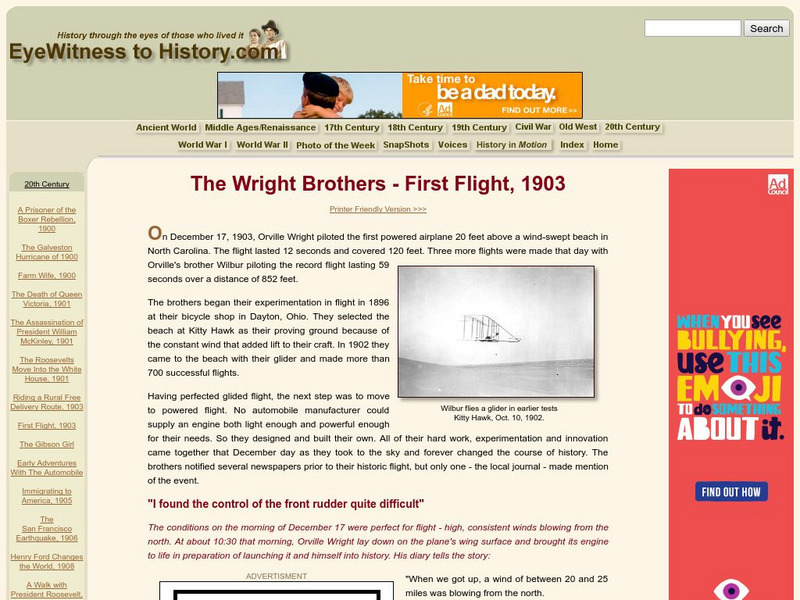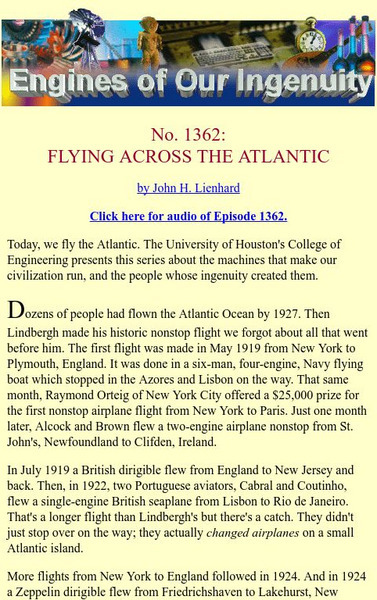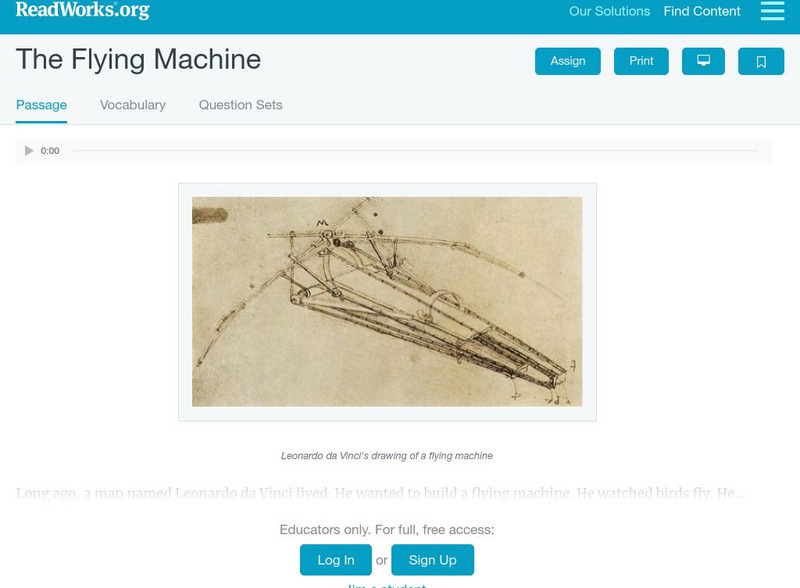Hi, what do you want to do?
Other
Modern World History: The Industrial Revolution Begins in England (1760 1850)
In this textbook unit, students learn the reasons why the Industrial Revolution took root in England first, and the innovations that made this possible. These included textile inventions such as the flying shuttle and the spinning jenny,...
Ibis Communications
Eye Witness to History: The Wright Brothers First Flight 1903
Orville Wright's account of his and his brother's first three airplane trial flights.
University of Houston
University of Houston: Engines of Our Ingenuity: No. 1362: Flying Across the Atlantic
Article discussing the early flights across the Atlantic. This is a transcript of an accompanying radio broadcast.
Library of Congress
Loc: Full of Hot Air
Did you know that the hot-air balloon is the oldest form of successful human flight? Briefly described is the history and construction of hot-air balloons. Follow the link to "images of hot-air balloons and balloon racing" to view...
Smithsonian Institution
National Air and Space Museum: Wright Brothers: Invention of the Aerial Age
Biographical details about the Ohio-born Wright brothers, who ushered in the aerial age with their invention of the first powered airplane.
University of Houston
University of Houston: Women in Flight
Beryl Markham's contribution to aviation history is discussed in this lengthy article. Facts about many other famous female aviators before and after Markham are also included.
Scholastic
Scholastic: The Flight of Amelia Earhart
A lesson unit to help students in grades 4-8 learn about the life and disappearance of Amelia Earhart. The interactive timeline shows advances in technology and the world as a backdrop to Amelia's life.
University of Houston
University of Houston: Engines of Our Ingenuity: No. 1342: Wright and Langley
Read about the controversy that emerged over the authenticity of Samuel Pierpoint Langley's flying machine, and the response of the Wright Brothers to attempts to usurp their place in history. This is a transcript of a radio broadcast.
Exploratorium
Exploratorium: Third From the Sun
This site offers a short history of the evolution of the space program and man's quest for more revealing and detailed pictures of the earth.
University of Houston
University of Houston: Engines of Our Ingenuity: No. 1409: The Redoubtable Dc 3
Read about the success of the DC-3 passenger plane, which went into use in 1936, in overcoming the difficulties such planes had encountered up until then. This is a transcript of a radio broadcast.
Smithsonian Institution
Smithsonian Libraries:taking to the Skies: Wright Brothers, Birth of Aviation
An article regarding the Wright brother's history of flight. Includes pictures and further reading material.
Smithsonian Institution
National Postal Museum: Fad to Fundamental: Airmail in America
A comprehensive site of the history of airmail in America.
A&E Television
History.com: What Was Flight 93's Target?
When the plane crashed in a Pennsylvania field on September 11, it was 20 minutes flying time from the nation's capital. On the morning of September 11, 2001, 46 minutes into United Airlines Flight 93, a nonstop flight from Newark, New...
Wikimedia
Wikipedia: Burt Rutan
A biography of Burt Rutan, an aircraft designer who created a plane that overcame one of flight's last great challenges - circling the world without stopping or refueling. Describes the many aircraft he designed.
Read Works
Read Works: The Flying Machine
[Free Registration/Login Required] This informational text passage gives a brief history of the airplane and ideas that came before the invention. This passage is a stand-alone curricular piece that reinforces essential reading skills...
A&E Television
History.com: How Military Service Teams Dominated College Football During World War Ii
'Bear' Bryant, who became a legend at Alabama, and future Pro Football Hall of Famers were among the all-star collection of talent. With football fields viewed as proving grounds, the military fielded teams that competed against top...
Royal British Colombia Museum (Canada)
First in the Air in British Columbia
The Royal British Columbia Museum traces the achievements of BC's first men to travel into the colony's atmosphere in the air. The site discusses the hot air balloon flight of Professor Leclaire in 1880 and the flight of Charles K....
A&E Television
History.com: Miracle of the Andes: How Survivors of the Flight Disaster Struggled to Stay Alive
When an Uruguayan rugby team crashed in the Andes on Friday, October 13, 1972, cannibalism helped some survive two months in harsh conditions. The Uruguayan Air Force Fairchild F-227 had crashed into a glacial valley high in the Andes....
NASA
Nasa: Tests Versus Time in the Race for Space
This NASA site offers a good description of the ongoing space race during the Kennedy administration, discussing the "nip and tuck" of the Soviet-U.S. race. Also includes a description of Kennedy's new special assistant for science and...
Other
Uscfc: Jack Northrop and the Northrop Corporation
A biographical site about the man responsible for designing the sleek Vega that carried pilots on record-setting flights and for designing planes with a stressed skin over an internal frame.
Other
Wwi Aviation: An Illustrated History of World War One: The Eastern Front
Information on the aerial aspect of the war on the Eastern Front during WWI. Includes links to lists of each country's flying 'aces.'
NASA
Marshall Space Flight Center: Timeline of Rocket History
This graphical presentation includes a collection of more than 50 images and descriptions tracing rocketry from ancient times to the present day.
Smithsonian Institution
Smithsonian Learning Lab: Stories of the Wrights' Flights
This lesson plan has young scholars read primary materials from the Smithsonian collection written by the Wright brothers, and compare and contrast them to secondary sources, such as newspaper stories from the next day. There is...
Seeker
Seeker: Week of 8 18 14: Ancient Butterfly Headed Reptile Discovered
Read about the this flying reptile that has recently been rediscovered by scientists after approximately 80,000 years.






















